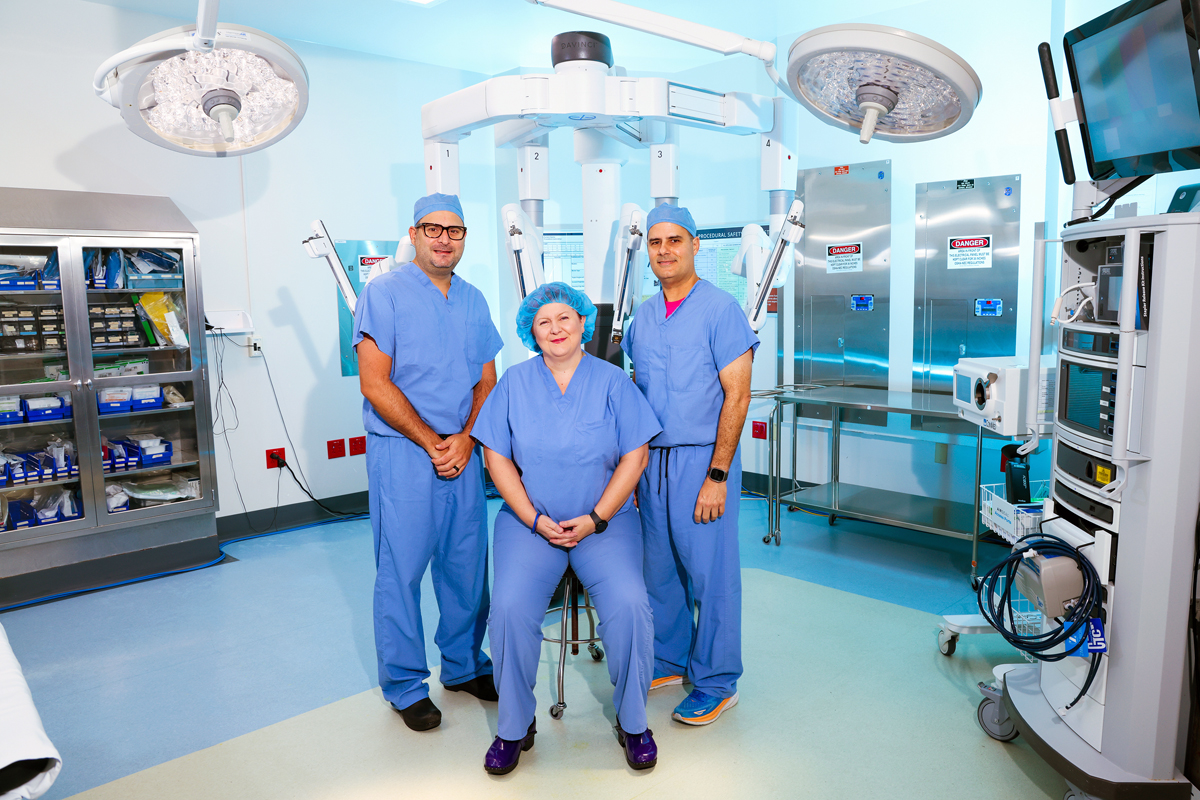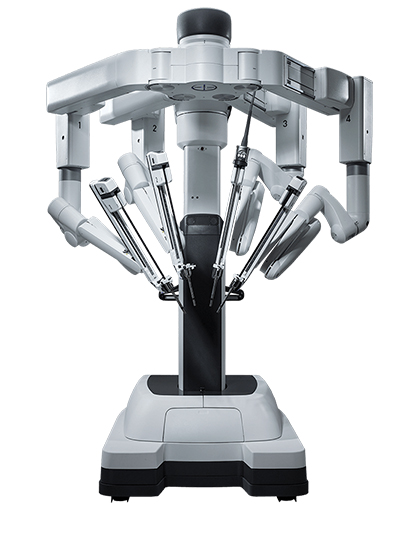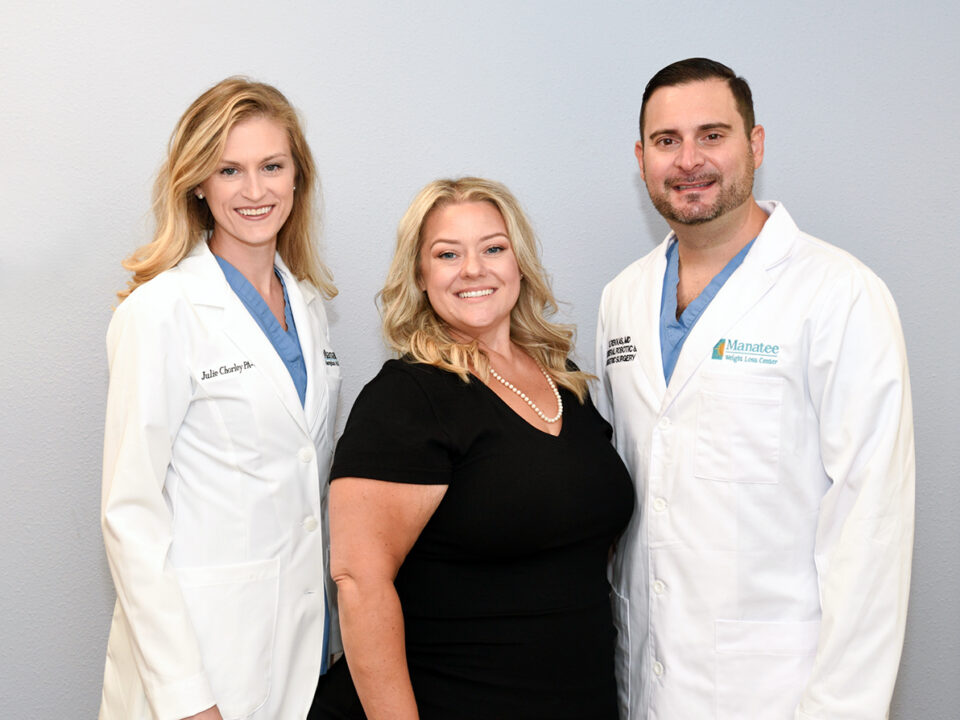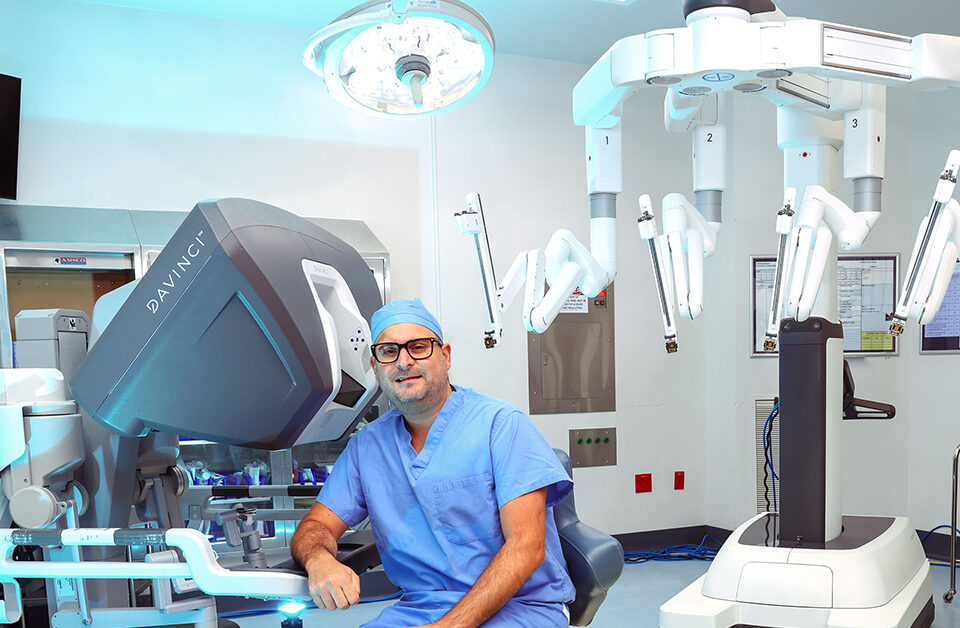

COURTESY PHOTO MANATEE MEMORIAL HOSPITAL
From left to right, Dr. Rekkas, Dr. South and Dr. Erbella stand in front of the da Vinci Surgical System’s four robotic arms, which are controlled remotely by the surgeon.
The days of a surgeon standing over their patient, holding out a hand and asking a nurse for a scalpel are not over, but they are fading.
They are at least for specialists such as Stelios Rekkas, MD, FACS, FASMBS, who is the medical director of the bariatric program at Manatee Memorial Hospital and a member of the Manatee Weight Loss Center/Manatee Physician Alliance.
Whenever Dr. Rekkas performs a vertical sleeve gastrectomy – a surgery to remove part of the stomach to aid in weight loss – he begins by sitting down at a console, tucking his head inside an oversized monitor and sliding his fingers around a series of small levers.
Steps away, a seven-foot-tall, four-armed robot known as the da Vinci® Surgical System precisely mimics the movements Dr. Rekkas performs as he manipulates those levers.
One mechanical arm creates a small incision – about a third of an inch long – in the patient through which another arm delivers a 3D camera and light that allows the surgeon to clearly see the surgical cavity on the monitor screen.
Through two other similarly sized incisions, robotic arms under the control of Dr. Rekkas introduce the long, narrow tools used to expand the abdomen and remove a portion of the stomach.
About an hour to 90 minutes later, when the work inside the cavity is done, the robot removes the tools from the body. Only then, does the surgeon get up from the console and stand over the patient to close the incisions.
Once considered futuristic, robot-assisted surgery is fast becoming commonplace. For example, it is common to use the da Vinci Surgical System for bariatric procedures such as sleeve gastrectomy and gastric bypass, in which the stomach and small intestine are altered to reduce food absorption.
“Robotic surgery is a marvel of modern medicine,” Dr. Rekkas enthuses. “It allows me to perform complex procedures with greater precision and accuracy than ever before, and for the patient it allows for better outcomes, less pain and a faster recovery.”
-Dr. Rekkas
At Manatee Memorial Hospital, surgeons have access to three da Vinci systems. The surgeons are fortunate for that, and the vast investment the hospital has made in these robotic platforms.
Dr. Rekkas says, “It’s hard to put a price on getting people healthier, preventing complications, decreasing hospital stays and getting people back to work.”
Assist and Augment
Manufactured by Intuitive Surgical, the da Vinci Surgical System first gained clearance for use by the FDA in 2000. It is truly a turn-of-the-century innovation that still seems new to many.


COURTESY PHOTO
da Vinci Surgical System
“When I tell a patient I’m going to be using the da Vinci Surgical System, they inevitably ask me, Well, who’s doing the surgery, you or the robot?” Dr. Rekkas relates. “I can assure you the surgeon is the one doing the surgery.
“The surgeon is always in complete control of the robot. The robot does not make any decisions. All the robot does is assist and augment what the surgeon does.”
That assistance is provided by the system’s interactive robotic arms, which can hold medical objects such as scalpels, scissors, and graspers.
While sitting at the console from which they control the robot’s actions, surgeons have a magnified, three-dimensional view of the surgical area.
“The difference that it makes is like the difference between threading a needle with your eyes and threading a needle with a microscope”, Dr. Rekkas says.
“Because of the work of the robot, it causes less trauma to the patient’s body because the robot allows surgeons to work through very small incisions that cause less damage and less postoperative pain.”
The sleeve gastrectomy, hysterectomy and hernia repairs perfectly demonstrate the benefits of robot-assisted surgery.
For years, these procedures were done through a much greater incision, and the surgeon had to stand over the patient and manipulate instruments manually.
“It was hard to see sometimes, and it was a very stressful procedure,” Dr. Rekkas explains. “But now, once those incisions are made, a camera goes inside one of them that allows me to see everything inside clearly and in a three-dimensional environment.”
In addition to causing less trauma and pain, the da Vinci Surgical System allows surgeons to complete procedures in less time than traditional surgery. Robotic-assisted surgery is also considered safer because the mechanical arms are more stable than any surgeon’s hands.
“By providing these robotic systems, Manatee Memorial Hospital has done a great job of providing us with the tools we need to do our best work,” Dr. Rekkas says. “It has taken the initiative to be an advanced minimally invasive surgical center that also provides excellent nursing care.
“As a result, most patients stay only one day in the hospital and, with the coordinator’s help, we make an impact and a difference in our patients’ lives.”
Multiple Applications
Surgeons must be trained in the use of the system to operate it. The da Vinci system is approved for dozens of procedures, including prostate removal, gall bladder removal, urinary bladder removal, uterine fibroid removal, hysterectomy and lung transplants.
“There are a lot of applications it can be used for,” confirms Stacey South, MD, past chief of staff at Manatee Memorial, where she has completed more than 1,500 surgeries using the da Vinci Surgical System. “Robotic surgery is a tremendous asset to oncology patients, allowing cancers to be removed from the abdomen/pelvis and chest using minimally invasive techniques not previously available for such complicated surgeries. These patients can heal much faster, allowing them to enter into any ‘extra’ cancer treatments physically and mentally stronger.
“The da Vinci Surgical System can be used to remove endometrial cancers, pelvic masses, or stop abnormal bleeding. We can also use it with some ovarian cancers. It’s something that’s becoming more and more common in hospitals these days.
“And that is because it offers the surgeon the opportunity to take a minimally invasive approach to surgery. That in turn allows patients to get back on their feet more quickly because there’s less trauma, less pain, less blood loss and less risk of infection.”
Dr. Rekkas remains astounded by the robotic system, even after using it for hundreds of procedures.
“There is no other way to put it other than to say that it is an amazing surgical tool,” the doctor concludes.
Individual results may vary. There are risks associated with any surgical procedure. Talk with your doctor about these risks to find out if surgery is right for you. Physicians are on the medical staff of Manatee Memorial Hospital, but, with limited exceptions, are independent practitioners who are not employees or agents of Manatee Memorial Hospital. The hospital shall not be liable for actions or treatments provided by physicians. For language assistance, disability accommodations and the nondiscrimination notice, visit the hospital’s website.













Leave a Reply